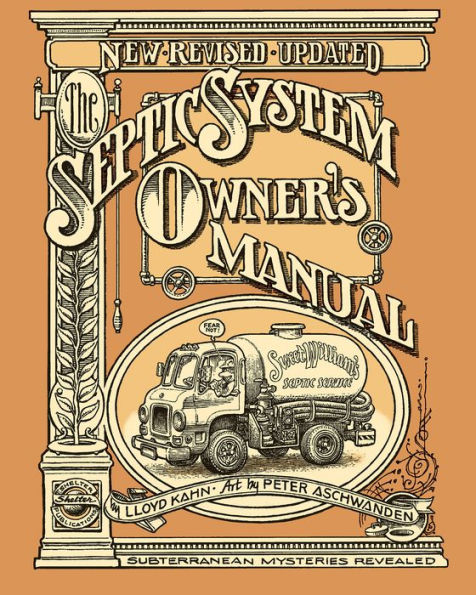Read an Excerpt
Red Alert! . . . System Failure
Your system has failed—that’s presumably why you’re reading this chapter. Water has backed up into the shower, the toilets won’t flush, and/or drains won’t drain. This means wastewater has backed up from the tank through the main drain into the house. It’s going the wrong way! Or—untreated effluent is surfacing on the ground. In this chapter we’ll talk about different types of failures, their causes, and what to do when your system fails.
Probable Causes of Failure
One or more of the following may have happened:
- The sewage pipe between the house and the tank is blocked or broken.
- Either the inlet or outlet tee is blocked or broken.
- The line between the tank and drainfield is blocked or broken.
- If the system has a pump, there may have been an electrical or mechanical failure.
- The tank itself is blocked with solids or has collapsed (an old redwood tank perhaps).
- The drainfield is flooded due to heavy rains or flooding.
- The drainfield is (partially or completely) clogged with solids or roots.
Locating the Problem
When the septic system is failing, there is a procedure for locating the cause, called the discovery process, in which you search for the problem in the following order:
System Blockage
You start by searching for a blockage somewhere in the system because this is the easiest cause to locate and the easiest (and cheapest) problem to solve.
- If only one fixture does not drain, check for blockage between the fixture and the main drain pipe. Use clean-outs for checking.
- If all fixtures on one branch of the drain pipe do not drain, check for blockage in that branch. Also, check the tank inlet for blockage.
- Open the tank. If it is flooded, the problem may be at the outlet or beyond. Check the outlet for blockage. If it is not flooded, you can check the various household fixtures by running a hose down them to see if the water makes it to the tank.
- If sewage is not arriving at the tank, then check for a pipe line blockage between the house and the tank.
- If both the outlet and the inlet tees are good but sewage is still backing up in the tank and house plumbing, the problem may be in the tightline (pipe between tank and drainfield) or the drainfield itself.
- To check the tightline, you’ll have to dig it up where it enters the drainfield. Try a plumber’s snake to check for a blockage between the tank and drainfield. Or, the tightline may be broken or sheared off. (See at right.)
- If the tightline is clear and intact, and all of the above steps have not produced the culprit, the drainfield is probably the problem. (See next page.)
Clearing Pipe Blockage
If the plumbing suddenly backs up under normal use, especially in dry weather, blockage is the prime suspect. This is generally the easiest problem to correct, particularly if it’s between the house and tank.
Most pipe blockages can be located using a plumber’s snake. (All tool rental stores have snakes.) Or, an old garden hose may work if there are not too many bends in the pipe. Also, there is a simple (and brilliant!) rubber device called the Drain King, which fits on the end of a garden hose. The hose is then run down the clogged drain pipe, and when the water is turned on, the bulbous rubber section expands, locks in the pipe, and emits strong pulsating bursts of water. These are available for 1- to 10-inch drains. (See Appendix, p. 174 for more information on the Drain King.)
Root Blockage
If you find that roots between house and tank are the problem, a Roto-Rooter can clear the line, but the roots will return if the entry points (leaks) are not found and sealed.
Tightline Breakage
A common problem is that the tightline (pipe between tank and drainfield) has broken. This often happens when the tank, which is very heavy when filled, has settled in the ground some time after installation, and the pipe has not flexed. (In some areas, new systems now must include a flexible coupling at the septic tank wall.) As with pipe blockage, snaking the line usually helps you find this problem, so the pipe can be either repaired or replaced. Sometimes it is easier and cheaper to replace the tightline, especially if roots are the problem, than to try to clear it.
Power Outage/Flooding
If you have an alternative system that uses electricity to pump the effluent to the drainfield and there is a power outage, the pump chamber should be checked immediately. If it is low, you’re OK, but monitor your water usage. If it is nearly full, water usage must be severely curtailed or the result will be effluent from the pump chamber backflowing into your house since there’s no electricity to pump the effluent to the drainfield—a distinct disadvantage to high-tech systems! You’ll have to wait until the electricity comes back on, or keep a small standby generator on hand for such emergencies.
If you live in an area with high groundwater and heavy rains, your tank and your pump chamber might be filling with rainwater runoff. It is wise to have good risers around the inspection holes of the septic tank since concrete lids generally leak. These risers are sold in many builders’ supply outlets. (See p. 50.)






